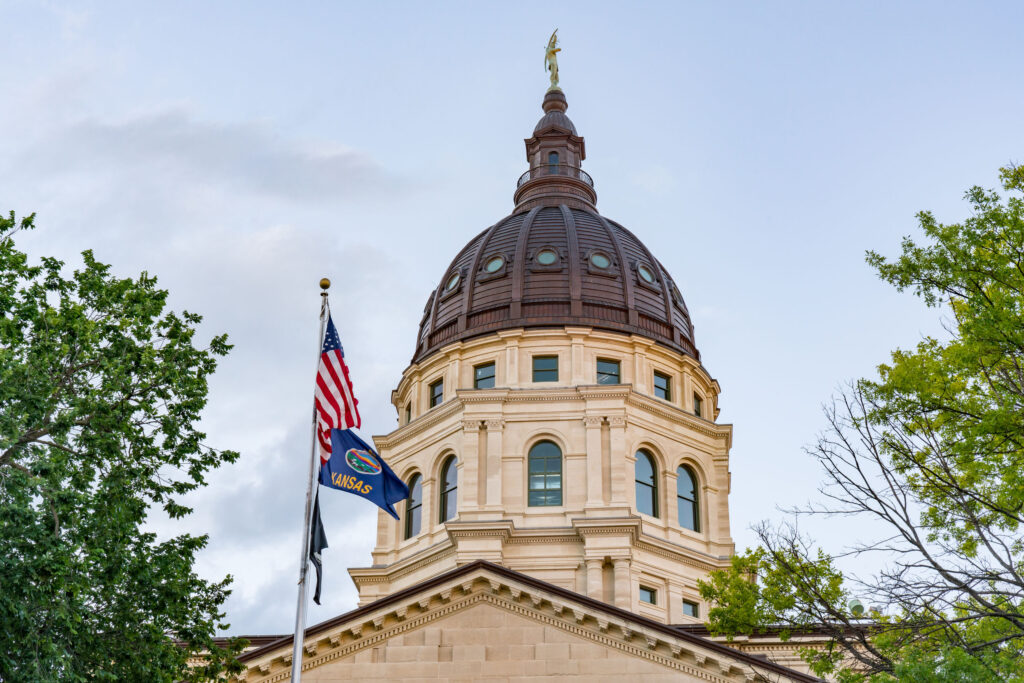While 24 other states have bolstered their economies through robust tax reform over the last decade, Kansas hasn’t progressed past its failed tax reform attempts under Governor Brownback. However, Topeka now sits on a multi-billion dollar pile of taxpayer cash that should be returned to families by cutting taxes.
A new report from KPI and Buckeye Institute, Reforming Kansas Tax Policy, creates a starting point for change. The report uses advanced statistical modeling to analyze how five different tax cuts could be implemented at the state level as well as what sort of effect each would have.
Regionally, Kansas’s seven percent corporate tax rate (6.5% in 2024) is significantly higher than many of its neighbors. According to the Tax Foundation, as of January 2023, Oklahoma and Missouri only tax companies at four percent; Colorado at 4.4 percent; Arkansas at 5.3 percent; and Texas does not tax corporate income at all. Only Nebraska and Iowa levy higher corporate taxes, and Iowa’s governor has just proposed reducing corporate taxes and eliminating state income taxes entirely.
“With regional competition for businesses and workers, Kansas must revisit pro-growth tax reforms to keep the state economically competitive,” said Zachary D. Cady, associate economist at the Economic Research Center at The Buckeye Institute and co-author of Reforming Kansas Tax Policy. “The tax reforms The Buckeye Institute analyzed can spur economic growth, and Kansas policymakers should strongly consider the results and pursue relevant policy changes.”
A budget projection released by the Kansas Legislative Research Department this week demonstrated that Kansas would have had a $4.5 billion surplus after four full years of tax relief from SB 169, a flat tax reform bill that was vetoed by Governor Laura Kelly during the 2023 legislative session. Speaker Dan Hawkins has indicated that a similar flat tax bill would be up for consideration during the 2024 legislative session.
Kansas families have struggled financially through COVID-19 into high inflation and are still trying to stay afloat amidst high food prices and poor job growth in the state. Individual income tax reform helps put more money back in these families’ wallets, with which they support their local communities. Similarly, cuts to the corporate tax rate increase investment in capital stock, which in turn leads to greater productivity, wages, and employment.
The Report
Using a dynamic scoring model—STELA (state tax and economic long-run analysis)—developed by economists at Buckeye’s Economic Research Center, the report’s authors analyzed five scenarios to give Kansas policymakers a better understanding of how each proposal will affect the state’s businesses, families, economy, and revenues.
For instance, the first scenario represents a combination tax package, similar to the vetoed SB 169, of $370 million personal income tax cut, $50 million corporate income tax cut, and $50 million sales tax cut. This policy would generate $390 million in economic growth and $220 million in business investment in the first year.
If Kansas does nothing to improve its tax policies, its economy will languish and fall further behind its regional peers. Kansas learned an important lesson from its failed tax reform – but its time to learn from the mistakes and not let the shadow of failed implementation continue to hold back the state.
Reforming Kansas Tax Policy was authored by Zachary D. Cady, an associate economist at the Economic Research Center; Rea S. Hederman Jr., executive director of the Economic Research Center and vice president of policy at The Buckeye Institute; and Trevor Lewis, an economic research analyst with the Economic Research Center.
Consistent with academic standards and methodologies, STELA underwent a double-blind peer review. A full methodology and technical description are available in the report’s appendix, allowing researchers to validate STELA’s accuracy and conclusions.




